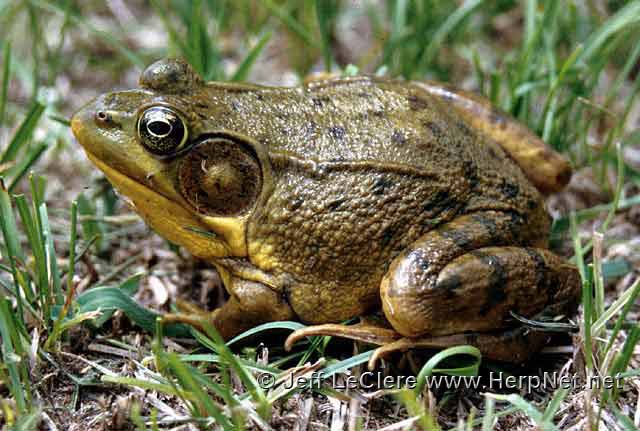Green Frog (Lithobates clamitans)
Alternate names: Rana clamitans
by Jeff LeClere

Green frogs, Lithobates clamitans, calling.
Status
A valid fishing license is required to possess this species for bait or food. The green frog was formerly considered a subspecies of the bronze frog.
Description
The green frog is Iowa’s second largest species of frog (only the American bullfrog is larger). They may measure 4 inches in body length. They are green or brown with no markings except perhaps some small black dots or dashes. Young green frogs may be heavily spotted. The upper lip is bright green. The underside is light with few gray or brown markings. Adult males usually have bright yellow throats. Males also have tympana (circular eardrum behind eye) that are larger than the eyes. Females have tympana that are equal to or slightly smaller than the eyes. Green frogs have dorsolateral ridges that extend from the eye down the back where they may break up before reaching the hind legs. This separates them from American bullfrogs, which lack these ridges, are larger, and have a larger range in Iowa. There are rare metallic blue color variations of this frog. These are probably axanthic specimens.

Subspecies
The green frog, Lithobates clamitans, has no recognized subspecies.
Range
The green frog is found in the eastern half of Iowa.

Habitat
Green frogs inhabit permanent bodies of water such as ponds, lakes, deep, permanent marshes, and other wetlands, such as streams and rivers.
Habits
Green frogs emerge in April, but they do not breed until May through July. The males’ call has been described as a “plunk” or “gunk” sounding like the pluck of a banjo string. It is a single note given once per second often four or five times in a row. The first “plunk” is the loudest, then they trail off. Males defend territories from other males. Females lay 3,000 to 4,000 eggs in a large mat. Tadpoles are green with small black dots and sometimes have yellow bellies. They transform their second year. Green frogs spend their time at the water’s edge waiting for prey. Green frogs move overland when there is a heavy rain. When startled, they may give off a warning call similar to the “meap!” of bullfrogs before leaping into the water.
Food
Green frogs will eat anything that they can swallow; mostly insects, earthworms, and even fish.
